2001: a space odyssey
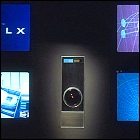 The product of a four-year collaboration between visionary SF writer Arthur C. Clarke and director Stanley Kubrick, MGM’s 2001: a space odyssey premieres, delighting fans of hard SF and bewildering audiences and critics. It is released alongside Clarke’s novel of the same story, which both clarifies some of the more inscrutible story points (such as the reason for the behavior of HAL, the ship’s computer) and confuses others (the book depicts a mission to Saturn; the movie depicts a mission to Jupiter). Many critics and science fiction writers regard the movie as an instant classic of the genre, one which continues to be hugely influential in the years and decades to come.
The product of a four-year collaboration between visionary SF writer Arthur C. Clarke and director Stanley Kubrick, MGM’s 2001: a space odyssey premieres, delighting fans of hard SF and bewildering audiences and critics. It is released alongside Clarke’s novel of the same story, which both clarifies some of the more inscrutible story points (such as the reason for the behavior of HAL, the ship’s computer) and confuses others (the book depicts a mission to Saturn; the movie depicts a mission to Jupiter). Many critics and science fiction writers regard the movie as an instant classic of the genre, one which continues to be hugely influential in the years and decades to come.
More about 2001 in the LogBook
Hear about it on the Sci-Fi 5 podcast
Planet Of The Apes
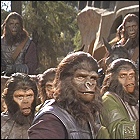 Starring Charlton Heston and Roddy McDowall, 20th Century Fox’s big-screen release of Planet Of The Apes quickly becomes one of 1968’s movie success stories, and easily one of the year’s two most influential genre films. Propelled into the future aboard a spacecraft from Earth, a trio of astronauts find themselves on a world ruled by sentient apes with no love of humanity whatsoever – for humanity nearly destroyed their world. The studio almost immediately sets the wheels in motion for a sequel.
Starring Charlton Heston and Roddy McDowall, 20th Century Fox’s big-screen release of Planet Of The Apes quickly becomes one of 1968’s movie success stories, and easily one of the year’s two most influential genre films. Propelled into the future aboard a spacecraft from Earth, a trio of astronauts find themselves on a world ruled by sentient apes with no love of humanity whatsoever – for humanity nearly destroyed their world. The studio almost immediately sets the wheels in motion for a sequel.
More about Planet Of The Apes in the LogBook
Hear about it on the Sci-Fi 5 podcast
Batman: The Movie
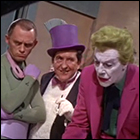 Based on the popular television series of the same name, 20th Century Fox’s feature film Batman premieres in American theaters, starring Adam West, Burt Ward, and, reprising their villain roles from the series, Cesar Romero, Burgess Meredith, and Frank Gorshin, while Lee Meriwether takes over the role of Catwoman. With a budget significantly greater than that of its TV counterpart, the movie introduces new Bat-vehicles, including a helicopter and a boat, footage of which will be spliced into many a later episode of the TV series.
Based on the popular television series of the same name, 20th Century Fox’s feature film Batman premieres in American theaters, starring Adam West, Burt Ward, and, reprising their villain roles from the series, Cesar Romero, Burgess Meredith, and Frank Gorshin, while Lee Meriwether takes over the role of Catwoman. With a budget significantly greater than that of its TV counterpart, the movie introduces new Bat-vehicles, including a helicopter and a boat, footage of which will be spliced into many a later episode of the TV series.
More about Batman in the LogBook and theLogBook.com Store
Batman now streaming on Amazon Prime
1965: a space odyssey
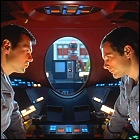 After a year of story development and refinement, filming begins on 2001: a space odyssey, directed by Stanley Kubrick and based on a story hashed out between Kubrick and SF writer Arthur C. Clarke from their mutual desire to create “the proverbial good science fiction movie” rather than the man-in-a-monster/robot-suit variety of movie that passes for science fiction in theaters. The film is budgeted at a hefty $10,000,000 – an impressive budget for the mid-1960s – including the construction of a rotating, hamster-wheel-like set for the interior of the spaceship Discovery. The unusual post-production and effects demands of 2001 will keep the movie “in production” for over two years.
After a year of story development and refinement, filming begins on 2001: a space odyssey, directed by Stanley Kubrick and based on a story hashed out between Kubrick and SF writer Arthur C. Clarke from their mutual desire to create “the proverbial good science fiction movie” rather than the man-in-a-monster/robot-suit variety of movie that passes for science fiction in theaters. The film is budgeted at a hefty $10,000,000 – an impressive budget for the mid-1960s – including the construction of a rotating, hamster-wheel-like set for the interior of the spaceship Discovery. The unusual post-production and effects demands of 2001 will keep the movie “in production” for over two years.
The proverbial good science fiction movie
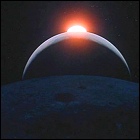 Director Stanley Kubrick writes to author Arthur C. Clarke, initiating a lengthy discussion about “the proverbial really good science fiction movie”, a discussion which eventually leads to the movie (and novel) 2001: a space odyssey. Kubrick’s letter mentions that he is particularly interested in exploring the theme of the effects that first contact with an alien race would have on humanity.
Director Stanley Kubrick writes to author Arthur C. Clarke, initiating a lengthy discussion about “the proverbial really good science fiction movie”, a discussion which eventually leads to the movie (and novel) 2001: a space odyssey. Kubrick’s letter mentions that he is particularly interested in exploring the theme of the effects that first contact with an alien race would have on humanity.
More about 2001 in the LogBook
Hear about it on the Sci-Fi 5 podcast
Godzilla, King Of The Monsters!
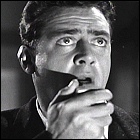 The first Godzilla movie, Gojira, is re-released in America, dubbed into English with additional scenes starring actor Raymond Burr, as Godzilla, King Of The Monsters! Despite the quite noticeable differences between old footage and new, the movie proves popular, and sparks the western world’s obsession with Toho Studios’ signature creation. It is also just the first of several attempts to westernize the Godzilla mythos (chiefly for American audiences).
The first Godzilla movie, Gojira, is re-released in America, dubbed into English with additional scenes starring actor Raymond Burr, as Godzilla, King Of The Monsters! Despite the quite noticeable differences between old footage and new, the movie proves popular, and sparks the western world’s obsession with Toho Studios’ signature creation. It is also just the first of several attempts to westernize the Godzilla mythos (chiefly for American audiences).
Gojira
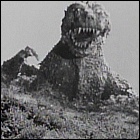 The first Godzilla movie, Gojira, debuts in Japan. Directed by Ishiro Honda and starring Akira Takarada, Momoko Kochi and Akihiko Hirata, the film is intended to be an allegory to the ravages of the atomic bomb rather than the beginning of a franchise (though the door is clearly left open to a sequel by dialogue at the close of the movie). The franchise proper will not begin until the first sequel five years later. In the meantime, an American dub of the movie attracts worldwide attention to Gojira, eventually rechristening the character Godzilla for much of the world.
The first Godzilla movie, Gojira, debuts in Japan. Directed by Ishiro Honda and starring Akira Takarada, Momoko Kochi and Akihiko Hirata, the film is intended to be an allegory to the ravages of the atomic bomb rather than the beginning of a franchise (though the door is clearly left open to a sequel by dialogue at the close of the movie). The franchise proper will not begin until the first sequel five years later. In the meantime, an American dub of the movie attracts worldwide attention to Gojira, eventually rechristening the character Godzilla for much of the world.
The War Of The Worlds
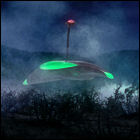 Paramount Pictures releases the George Pal-produced movie adaptation of H.G. Wells’ The War Of The Worlds in American theaters, starring Gene Barry, Ann Robinson, and Les Tremayne. Featuring groundbreaking special effects photography and painted space scenes by Chesley Bonestell, the movie is an instant hit, and will later inspire a television revival based on elements of this film.
Paramount Pictures releases the George Pal-produced movie adaptation of H.G. Wells’ The War Of The Worlds in American theaters, starring Gene Barry, Ann Robinson, and Les Tremayne. Featuring groundbreaking special effects photography and painted space scenes by Chesley Bonestell, the movie is an instant hit, and will later inspire a television revival based on elements of this film.
